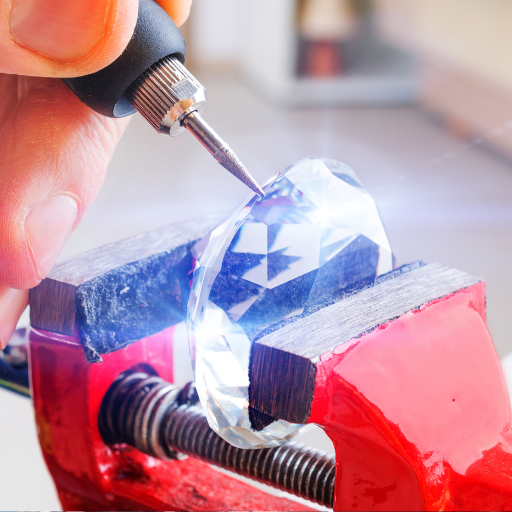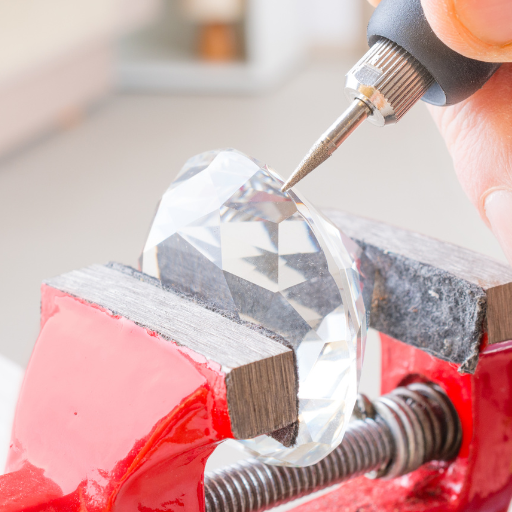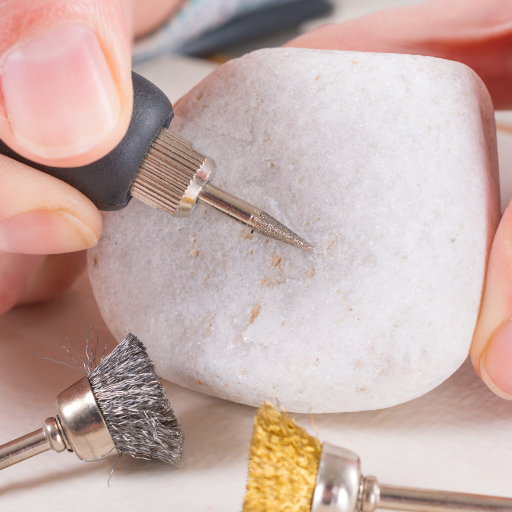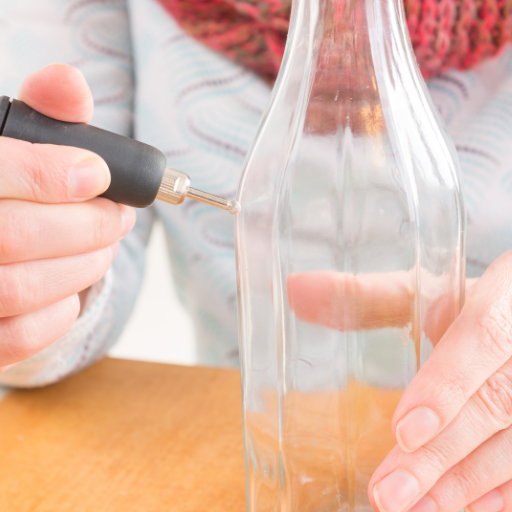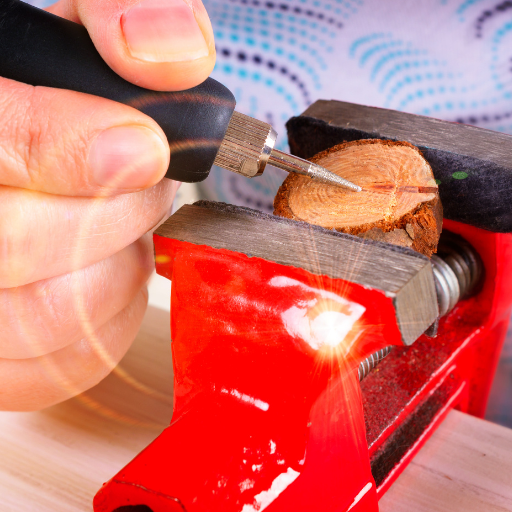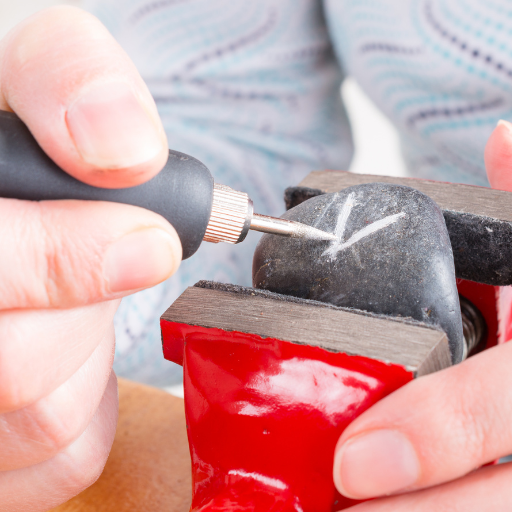The writing system of a rotary engraving is an advanced method that combines artistry and mechanical precision to provide an adaptable format for creating intricate designs on diverse surfaces. This blog post seeks to look into the core issues that involve rotary engraving, and it will show some of the materials that can be used such as metals, plastics, glass and wood. The piece will also talk about different types of machines which are needed to carry out this art starting from simple hand operated ones to modern computerized systems offering unique advantages. In addition, we shall analyze the various techniques employed in the process of rotary engraving including some tips for achieving best results. Either you are an inexperienced learner who wants to know where to begin or an experienced technician trying to perfect your skills; through this complex realm of rotary engraving navigation, there is no better guide than this extensive account.
What Materials Can You Engrave with Rotary Engraving Machines?
Rotary engraving machines are highly adaptable and have the ability to make engravings on a variety of different materials. Aluminum, brass, copper, and stainless steel are typical metals that are engraved because they have good wear resistance and aesthetic properties. Of course plastics such as acrylic, polycarbonate or ABS are easy to engrave and can be used in many applications. Softwoods like pine through hardwoods such as oak and maple also make good options with their unique textures and grains. Glass engraving using rotary machines is quite popular for producing decorative patterns, though requires special tools to deal with brittleness of the material. In addition to this, there still exist other items like leather; stone among others which can also be engraved implying a wide range of usage for rotary engraving across different sectors or fields.
Choosing the Right Material: Metal, Plastic, and More
In choosing the right material for a rotary engraving, one should have in mind both the technical parameters and what is expected. Due to their durability, corrosion resistance and strength, good choices are aluminum, brass and stainless steel among other metals. For instance, while aluminum is light-weight and conductive, brass is machinable with attractive antiqued appearance whereas stainless steel has high hardness as well as wear resistance.
There are a variety of plastics such as acrylics, polycarbonates or ABS that are preferred due to versatility and ease of use. Acrylic’s clarity and light-diffusing properties make it ideal for signage; polycarbonate is chosen because of its impact resistance and toughness; ABS stands out because of its strength combined with heat resistance.
Different types of wood also vary in suitability; softer woods like pine are easier to engrave but may offer less defined edges than harder ones such as oak and maple which provide a richer finish as well as durability. When trying to achieve the right quality, correct spindle speeds coupled with appropriate feed rates are mandatory — usually soft materials require higher spindle speeds but lower feed rates.
For glass engraving, this calls for specialized tools such as diamond tipped or carbide bits since the material is very brittle. Others include leather, stone amongst other composites which when engraved need some special tools and settings based on their properties. Having these technical considerations ensures effective results while at the same time prolonging the life span both of an engraving machine itself plus used tools.
Understanding the Impact of Material Surface and Type on Engraving Quality
My experience tells me that material surface and type affect engraving quality profoundly and with multiple angles. Different materials have diverse responses to engraving tools, which influence aspects like edge definition, depth, and consistency. Materials such as metals, plastics, wood, glass, leather, stone or composites pose different challenges or rewards. For example aluminum and stainless steel are tough yet they require accurate manipulation because of their hardness. On the other hand plastics such as acrylics and polycarbonate can be reshaped more easily though they behave differently in heat. Unlike lighter woods like pine oak and maple are known for being solid but should be worked on differently. Glass being so brittle requires special tools while leather or stone need adjustments to prevent damage hence increase clarity. By carefully selecting appropriate tools and settings depending on the properties of a given material I can achieve remarkably high quality and accurate engravings.
Effective Rotary Engraving of Laminates & Acrylics
When it comes to rotary engraving laminates and acrylics there are few practices that make it more effective and produce high quality results. The first thing to keep in mind is the choice of an appropriate engraving bit; carbide bits or diamond bits are recommended due to their long life span as well as sharpness respectively. Depending on whether one is working with acrylics or laminate materials spindle speeds should be adjusted accordingly so as not to risk chipping at lower speeds for laminates or melting at higher speeds for acrylics ones . Using coolant/air assist will reduce heat build-up that can cause damage to the material because it ensures less frictional force during cutting operation. Always bear in mind that a clean work surface without any debris will result in smooth cuts with minimum distortion possible during engraving processes.It is crucial also trying out all these settings through samples before actual work begins from scrap pieces which may help adjust them better if required before proceeding with real thing itself.By following these tips and constantly improving one’s skills level, much higher engraving quality can be reached on both laminates and acrylics.
The Fundamental Differences Between Rotary Engraving and Laser Engraving
The fundamental difference between rotary and laser engraving lies in their techniques and applications. Applying a spinning bit, rotary engraving physically takes away material, making it highly efficient in creating deep tangible engravings on various surfaces including metal, plastic or wood. This method is often preferred for its durability and the pronounced texture it provides thus ideal for items like trophies, nameplates, and signage.
On the other hand laser engraving uses a concentrated beam of light to vaporize material thereby leaving behind precise high-resolution marks. This non-contact technique can be used on delicate materials such as glass or leather with great detail and minimum effort on intricate designs as well. Laser engraving therefore has speed advantages over the others because of the complexity required while manufacturing products containing several patterns such as jewelry, electronics or promotional items.
It all depends on whether depth and texture are critical (rotary) or precision and smoothness matter more (laser), when choosing between rotary engraving which excels at depth & texture versus laser engravers that are great at accuracy & detailed work.
Comparison of Engraving Depths, Precisions, and Finish Qualities
Generally speaking rotary engraving offers greater depths than laser cutting due to its mechanical cutting process which makes it suitable for applications with deep grooves and textures whereas laser methods excellently deal with precision by producing high-resolution designs with detailed intricacies that cannot be achieved through rotating methods. The finish quality of engraved surfaces also varies: Rotary engraving results in a rougher textured surface while laser methods produce smoother finish especially good when sharp lines/fine details are needed in designs. Between these two different approaches though there is an understanding that some people choose based upon specific needs – either wanting something deeper feeling like tactile feedback (i.e., Braille signs) where disabilities require accommodations through touch (these will be called ‘tactile’ here) or preferring ‘cleaner’ looks achieved by rasterizing everything else out of existence save for what needs to stay visible, such as when working on different materials at various depths as demanded by industrial processes like making signs or doing crafts.
Why Choose Rotary Engraving Over Laser for Certain Applications?
Rotary engraving is superior to laser engraving in some applications, particularly those that require a sense of depth and texture. A major advantage is that it can be used to achieve deep engravings in harder materials such as metal. This feature makes rotary engravers perfect for industrial tags labeling and nameplate manufacturing since these items are exposed to harsh environments. Additionally, because the process removes material physically, rotary cutting copes better with uneven surfaces.
Technical parameters supporting rotary engraving include:
- Engraving Depth: As opposed to laser engraving 0.25 inches is a typical maximum depth achievable by mechanical systems of this kind.
- Material Compatibility: Rotary machines cut through hard metals like brass or stainless steel without affecting the depth.
- Surface Adaptation: The irregularities of the surface can be conformed by a rotary cutter ensuring consistent engraving even on rough surfaces.
- Tool Wear and Durability: Unlike lasers which may experience beam quality degradation due to aging over time, rotary tools are easily replaceable thus operate reliably for long periods without compromising quality.
Rotary engraving is also preferred for applications requiring a tactile feel, such as braille signage or creating textures on various surfaces. While laser engraving excels in precision, rotary engraving’s versatility in handling different materials and depths makes it indispensable for many industrial and craft applications.
Material Suitability for Rotary vs. Laser Engraving
Understanding the material suitability for rotary vs. laser engraving involves evaluating several factors. Rotary engraving is highly effective for dense, tough materials like metals (e.g., stainless steel, brass, aluminium) and is adept at handling uneven surfaces. This method creates deep, durable engravings, suitable for industrial applications, and can achieve a tactile end result, such as braille. On the other hand, laser engraving is preferred for intricate, detailed work on materials like wood, acrylic, glass, and certain metals. It provides high precision and clean edges but is generally limited to surface marking rather than deep cuts. Each technique has its strengths; rotary engraving is robust and versatile for heavy-duty tasks while laser etching excels in fine-detail projects and is optimal with softer substrates.
Exploring the Various Applications of Rotary Engraving
The diversity of applications and the adaptable nature of rotary engraving make it useful in many areas. The industrial field largely uses it to create long-lasting name plates, tags, and control panels that can withstand tough environmental conditions. Also, jewelry manufacturers rely on rotary engraving for fine designs and texts on items. At the same time, this methodology plays a significant role in manufacturing trophies and awards with inscriptions of better quality. Its possible integration into various types of materials like metals, plastics, wood or glass further expands its application.
Moreover, braille is a typeface made by rotary engraving which helps boost accessibility. Due to its versatility when it comes to surfaces and depths, rotary engraving has become indispensable across industries.
From Industrial Marking to Custom Jewelry: The Versatility of Rotary Engraving
Rotary Engraving is a versatile option for diverse industrial needs because it can be used for different materials and depths. In industries that do marking like industrial marking then rotary engraving provides durable solutions for nameplates and control panels that are resistant against severe environments. For example, the technicalities relevant here are spindle speed which ranges between 20 000 – 60 000 RPM; hence depending on hardness of the material such as material hardness will determine depth (mm) while tool depends on material being engraved.
In the jewelry industry rotatory engravings precision have made it possible to personalize jewelries at any level ranging from detailed texts to intricate designs. For softer metals like gold there is usually lower spindle speed around 15 000 RPM which ensure clean cuts without damaging a piece.
Machined brass or aluminum plaques often require close tolerances in order to render their highest quality images through high speed cutting with diamond tipped cutters.
For these purposes Braille must be engraved within ADA limits so as to allow raised dots that can be read by touching them. Commonly braille requires an etching depth between 0.5 and 1.5mm.
Rotary engraving is indispensable across different verticals due to its capacity to work with a wide range of materials including metals, plastics, wood and glass while also enabling precise control over engravings depth and detail.
Creating Unique Signage and Trophies with Precision
Rotary engraving machines are favored for their ability to create unique, high-quality signage and trophies due to their precision and versatility. It can be used on brass, aluminum, glass that are most commonly used in awards and plaques for producing fine details or clean cuts lines as it is capable of engraving fine details such as those required by nameplates or logos of various organizations. The diamond cutters ensure precise detail that lasts through time hence lasting longer than the engravings do under ordinary circumstances too. Besides this, rotary engraving allows for personalization of each piece as per the requirement of the client; therefore the company can give logos or messages whose names are intricate and detailed. Rotary engraving offers exceptional flexibility plus accuracy thus making it an ideal choice in manufacturing custom made trophies or plaques at professional level.
Choosing the Right Rotary Engraving Machine for Your Needs
When it comes to selecting the right rotary engraving machine, take into account your unique project requirements and materials you will work with. Machines vary in terms of the speed they have, their precision and ability to handle different materials. Beginning models are suitable for small businesses or hobbyists with very simple projects while industrial models are suitable for large scale jobs that require a lot of detail. Such factors as spindle speed, bed size, software compatibility, milling heads and cutters’ types should be taken into consideration when choosing engraving equipment. Other machines have various advanced features such as automatic tool-changers or vacuum beds which benefit productivity and ease of operation. Lastly remember that things like customer support, warranty and availability of spare parts play big roles in ensuring investment on engravers is not wasted.
Understanding Different Rotary Engraver Models and Their Capabilities
Different rotary engraver models do differentiate themselves greatly based on their intended applications and capabilities. Entry-level models are often less powerful than others making them ideal for small businesses or hobbyists who don’t require much power in their machines. Mid-range rotary engraving systems offer faster speeds, better accuracy, as well as increased material choice for the more intricate tasks in different industries. On the other hand high-end industrial machines have come along with complex functionalities including automated tool change system; larger bed area; higher spindle speed for those huge or complicated works among others that carve beautiful designs onto pieces made from various materials. Furthermore these usually possess robust software compatibility that enables linking up with design packages featuring intricate patterns or motifs effortlessly; otherwise you could get stuck midway during developing.
Evaluating Machine Size, Engraving Area, and Tool Options
Evaluating how big a rotary engraver is important to make sure it fits inside your available space comfortably without compromising on your desired project size requirements. A large machine will typically come with significant working areas allowing one to undertake multiple jobs simultaneously thereby increasing productivity levels within just a short span. A tiny version would be more appropriate for detailed work or if your workspace is limited. The engraving area has to accommodate the largest possible size of the pieces being produced, as well as thickness and type of materials that will be used. Different bits, their sizes and compatibility with accessories also influence the flexibility and functionality of a machine. Advanced machines have automatic tool changers which automate the process and reduce downtime due to sharpening. As such, there is need to balance between the size of the machine, its engraving area and its tool capabilities so as to optimize efficiency while producing quality output as per individual preferences.
Accessory Considerations: Cutters, Diamonds, and Spindles
Cutters are key accessories for rotary engravers which can come in various forms like material (HSS or carbide), shape or size depending on what one wants to accomplish cutting through different materials. HSS cutters are efficient for soft substrates while carbide ones perform well on harder materials due to their strength. Diamonds are useful for very intricately detailed tasks such as glass etching in industry where they yield accurate results without causing any damage during operation. Diamond-tipped instruments ensure durability even when employed over long periods under heavy workload industrial applications thus remaining sharp all along. Since spindles are utilized in this devise’s functioning it should be noted that it is important part of any machine used in this manner. Engraving with fine details requires higher RPM spindles which give smoother finishes; however lower RPM ones can go deeper into hard-to-cut structures /materials as they don’t require thin lines only but deep grooves resulting from engraving tools’ rotation speeds too low those areas shall not be affected deeply by them either way since an array variables must be taken into account whilst selecting these devices including durability factor above all else.
How to Engrave Custom Designs: Tools, Tips, and Techniques
For effective engraving of personalized ideas, there are some steps you need to follow. For instance, first select the most suitable software such as Adobe illustrator or Coreldraw for importing or creating your custom design. Vector-based designs are the best for engraving purposes. Your design should be transferred to the laser engraver software that will make it possible to adjust material and depth settings and choose proper tools including cutters, diamonds or spindles in accordance with a type of material. During this process, it is important to ensure that you have selected the right tool whether a cutter, diamond or spindle for cutting different materials like acrylics. Consequently, apply test runs on similar scrap material for fine-tuning machine parameters which include speed control, pressure system and intensity of work being done. A good number of artists who use these types of machines advise owners to always maintain their equipment because they can only deliver consistent results if they are clean every time you wish to put them into operation while wearing proper protective clothing.
Mastering The Craft Of Custom Engraving: From Jewelry To The Signage
Mastering this art entails a mix of technical know-how, creativity and having an array of tools at hand. First things first; get well acquainted with your materials since diverse substrates such as metals; glass; wood; acrylic among others call for specific engraving methods as well as tools. For intricate designs that may be used on jewelry pieces especially one would require precise and delicate tools like diamond tipped scribers. On larger projects such as signage however heavy duty machines capable of doing deeper engravings on large surfaces areas are required.Also remember always during calibration processes carry out test runs that ensure perfect machine’s setting thus leading to accurate results while keeping your equipment maintained so you can always have good outcomes from work done professionally.Safety must be paramount which calls for using safety gear including goggles when trying out new things.Learning continues through online forums, tutorials and communities in which the most creativity is born.
Engraving Tools and Accessories that Ensure Precise Custom Work
When it comes to choosing essential engraving tools and accessories, accuracy as well as compatibility with your materials should be kept in mind. Among the frequently used instruments are rotary engravers because they are adjustable for different media types and laser engravers since they can be very precise on metals or plastics. For instance, diamond tipped scriber or micro engraver would be necessary to make more delicate engravings especially on jewelry items. Furthermore, there are certain things like gravers, burs and templates that help an artist achieve fine details connected with their works. It is still preferable to use high quality vector design software in order to form correct patterns where scaling options will also assist someone in achieving best results. Consequently good ventilation systems, clean workspaces equipped with jigs and fixtures for securing work pieces safely alongside dust extraction systems are required for enhanced safety and proficiency while personal protective clothing such as goggles have been found necessary during most of these processes.The maintenance procedures that should always be done include keeping both tools and equipment at a good working condition so that an accurate setting of your laser machine continues even after long time use.
Software And Settings: How To Get Perfect Engraving Depth And Detail
When seeking to achieve the perfect engrave depth and detail, you need to select the right software for your personal engraving machine which include Easel, LightBurn, or CorelDRAW. These applications allow for extensive control over design parameters and settings. For instance, increase dot per inch (DPI) value to improve detailed quality of items produced; cranked up DPI settings lead to more intricate engravings. Adjust power and speed as appropriate: slow down but increase the strength when cutting deeper while in case of light materials use high speed with low power is recommended. Moreover, do some test engraves as a way of refining them so that they can be perfect. In detailed work, vector designs tend to produce more readable lines than raster images. Lastly, keep your machine’s firmware up-to-date for possible increases in performance and accuracy.
Learn More About Rotary Engraving: Techniques and Best Practices
Rotary engraving is a versatile technique widely used for creating precise and detailed engravings on various materials such as metals, plastics, and wood. To achieve optimal results, it’s crucial to choose the right cutting tool or bit for the material at hand, with carbide-tipped bits being a popular choice for their durability and precision. Adjusting spindle speed and feed rate according to the material’s hardness can greatly enhance the quality of the engraving. Properly securing the workpiece is essential to prevent movement and ensure accuracy, often achieved through the use of a vice or clamps. Engraving software that supports rotary tools, such as Gravostyle or EngraveLab, can streamline the design and setup process. Regular bit maintenance, including sharpening and cleaning, is necessary to maintain the quality of engravings and prolong tool life. Finally, consistent practice and experimentation with different settings and materials will help develop expertise in rotary engraving.
Mastering Depth Adjustment and Tool Setting for Perfect Results
Achieving perfect results in rotary engraving requires meticulous attention to depth adjustment and tool setting. Start by setting the depth of the engraving to the desired level, which can be done through the machine’s software or manually. The depth should be consistent to ensure uniform engravings, often achieved by testing on scrap material before beginning the actual project. Adjusting the spindle speed and feed rate according to the material’s properties is crucial; harder materials typically require slower speeds to avoid damaging the cutting bit. Using the correct tool setting for each bit is essential to maintain precision—this can involve calibrating the machine to recognize the exact length and type of the bit being used. Regular bit maintenance, such as proper cleaning and sharpening, helps maintain engraving quality. Ensuring that the workpiece is securely clamped will prevent movement that can compromise accuracy. Employing high-quality, carbide-tipped bits can also enhance the clarity and detail of the engravings.
Software and Vector Adjustments for Detailed Engravings
Detailed engravings are significantly influenced by the precision of software and vector adjustments. Utilizing advanced software such as Adobe Illustrator or CorelDRAW provides comprehensive tools for creating and manipulating vectors, ensuring clean and precise designs. These programs allow for intricate detail adjustments, including node editing and path modifications, which are crucial for achieving sharp and accurate engravings. Converting images or designs into vector format helps maintain clarity at any scale, ensuring that the engraving remains sharp and detailed. Additionally, setting the correct line thickness and ensuring that all elements are properly aligned and spaced within the design software can greatly affect the final engraving quality. Employing high-resolution images during the vectorization process minimizes pixelation and enhances detail. Finally, consistently updating the software to access the latest features and tools will further improve the precision and quality of detailed engravings.
Reference sources
- Gravotech
- Source Link: Discover the Rotary Engraving Technology
- Summary: Gravotech details the rotary engraving process, describing it as a machining technique that uses a rotating drill to hollow out material. The article provides a clear explanation of how cutting tools are employed in this precise method, emphasizing its application in various industries.
- Xometry
- Source Link: What is Rotary Engraving?
- Summary: Xometry offers a comprehensive overview of rotary engraving, explaining its origins and the mechanical process involved in physically removing material with an engraving drill. The resource serves as a credible guide for understanding the fundamentals and historical context of rotary engraving.
- Brunel Industrial Engraving
- Source Link: The Ultimate Guide to the Best Engraving Techniques
- Summary: Brunel Industrial Engraving provides an in-depth look at rotary engraving systems, highlighting the use of computer-controlled rotating cutting tools in motorized spindles to achieve detailed and precise engravings. The guide is valuable for readers seeking detailed technical information on engraving techniques and their applications.
Frequently Asked Questions (FAQs)
Q: What materials are commonly used in rotary engraving?
A: Rotary engraving is incredibly flexible, capable of handling a diverse range of materials. These include metals like anodised aluminium, brass, and stainless steel, as well as plastics and acrylics. More delicate items, such as pens, perfume bottles, or bracelets, can also be customised through this method. It’s ideal for both decorative and functional applications.
Q: What are the advantages of using CNC machines for rotary engraving?
A: CNC (Computer Numerical Control) machines bring precision, efficiency, and versatility to the engraving process. They allow for highly detailed work on a variety of materials and objects, from small items like rings and medals to larger objects like signs and plates. With CNC machines, manufacturers can easily create complex designs and personalisation options that wouldn’t be possible with manual engraving.
Q: Can rotary engraving be used for gift items?
A: Absolutely, rotary engraving is perfect for personalising gift items. It’s a popular choice for engraving names, dates, or special messages on items such as pens, knives, bracelets, and rings. The precision of the engraving adds a meaningful and lasting touch to any gift.
Q: What are Gravotech’s contributions to the rotary engraving field?
A: Gravotech is a leading manufacturer in the engraving market, known for its innovative and high-quality machines and tools. Gravotech offers a range of products for both mechanical engraving and laser engraving, focusing on precision and versatility. Their solutions cater to a wide array of applications, from industrial manufacturing to personalized gifts, making them a go-to for businesses seeking reliable engraving services.
Q: How does the thickness of the material affect the engraving process?
A: The thickness of the material being engraved is an important factor to consider. Thinner materials, like flexible sheets or thin plates, require careful handling to avoid damage during the mechanical engraving process. Thicker materials may require adjustments in the engraving depth or use of a specific drill bit to achieve the desired result. It’s important to adjust the settings of your engraving machine accordingly to ensure optimal results.
Q: Is it possible to engrave on curved surfaces?
A: Yes, with the right equipment and technique, it’s possible to engrave on curved surfaces. This process may involve using specialized rotary attachments that allow the object, such as a pen or bracelet, to rotate, ensuring even engraving across its surface. This capability allows for a wide range of personalised items to be engraved, offering great versatility to businesses and hobbyists alike.
Q: What safety measures should be considered during rotary engraving?
A: Safety is paramount in all forms of engraving. Protective eyewear is essential to guard against flying debris. It’s also important to use the correct drill bits and settings for the material being engraved to prevent accidents. Additionally, ensuring that the object is securely fixed before starting the engraving process can help avoid slippage and potential injury. Following the manufacturer’s guidelines for machine operation and maintenance is crucial for a safe engraving environment.
Q: Can rotary engraving be used for serial production?
A: Yes, rotary engraving is well-suited for serial production, especially in the manufacturing sector. The process is highly repeatable, making it ideal for producing large quantities of engraved items, such as industrial tags, plates, and promotional merchandise. With the aid of CNC technology, the process can be automated, allowing for high-volume production with consistent quality.
Q: How can I learn more about purchasing a rotary engraving machine?
A: If you’re interested in acquiring a rotary engraving machine for your business or personal use, the best step is to contact manufacturers directly or through their official representatives. Companies like Gravotech have knowledgeable sales teams that can provide information on the different machines available, depending on your specific needs, and guide you through the purchasing process. They may also offer demos or samples of their engraving capabilities to help you make an informed decision.



